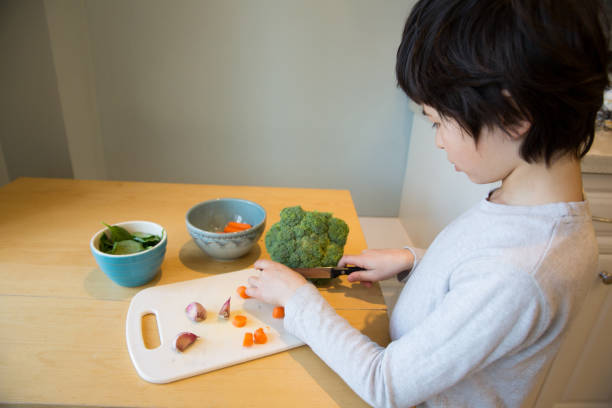8 Strategies for Picky Eaters: End the Mealtime Battles for Good

Is your dining table a battleground?
Do you engage in hostage negotiations over vegetables at mealtime instead of reflecting on the day?
Add insult to injury: Is the culinary masterpiece that you worked so hard on treated with contempt as your child throws it in the dog’s face or tells you how disgusting broccoli really is?
You’ll be surprised at how quickly you can lose your cool and drop your head on the table.
I understand you. As a working mom of two boys who were “picky eaters” when they were younger, I know the “picky” issues and mealtime meltdowns. After implementing some strategies, I was finally able to end the mealtime wars. It’s good to know that my sons, now adults, eat their vegetables. There is hope for everyone!
Here are eight steps to help you end the battle with picky eaters at home:
1. Labels are not necessary
When we label our children’s eating habits, or any other behavior for that matter, we only compound the problem. If you have a picky child and you marked them as such, you may be causing problems. You will tell your child to “not eat this” or “only eat macaroni and cheese.”
Labeling your child’s eating habits gives her permission to continue with the behavior. It will also unintentionally prevent your child from trying new foods.
Positive labels about eating can also cause more problems than they solve. When you label a child as a “good eater,” his siblings will assume that he is the “bad eater,” creating an environment where sibling rivalry can thrive. Avoid labels, whether positive or negative.
2. Take control of your pantry
You are the one who purchases the groceries. They may enjoy a few candy bars at the movie theater or a cake at a party, but the fact is that most children eat the majority of the food they eat at home.
Do they eat too many Oreos, or are they just eating them? Throw them away. Do they drink more Coke than you permit? Pour them out. Do they eat too much sugary junk food and starch-rich snacks in your house? Take them out of your refrigerator and pantry. All you can offer is healthy options, so that’s what they will eat.
Close the fridge (and pantry) an hour or so before dinnertime if your children are not eating most of what you have put in your pantry.
This change won’t be easy. But is here to help you. You can’t always control what your kids eat, but you can choose what they eat.
Note to Members of Positive Parenting Solutions: Please see Lesson #22 for more information about how to use the Control the Environment tool to ensure that morning routines are smooth and run smoothly, to minimize sibling rivalry to tame technological battles, and to diffuse all kinds of power struggles.
3. Do not go to war at the dinner table
Don’t make mealtime a fight if you don’t wish it to be. It is not necessary to debate what kids eat every night or how much. Your job as a parent is to prepare and serve healthy meals for your children. You’ve done well if you make sure to include one fit food item that you know your kid will eat. What’s next? Let it be. Seriously. You can let your child decide whether to accept it or not.
You can create a power struggle over food by saying well-intentioned things like “just try it” or “how will you know if it’s not for you if you don’t even try it?” You can give your children the power to cause problems if you’re too invested in them making the “clean-plate club.”
Let the chips fall where they may (in a figurative sense)! Let the chips fall where they will. Your kids will become more manipulative and anxious if you’re anxious about what to eat at mealtime.
Be Switzerland when it comes to eating. Stay neutral. Stay neutral.
You will find that your mealtimes are more enjoyable if you avoid the fighting.
4. Do not use food as a reward
You’ve probably heard it a lot: “If you finish your meal and eat all your vegetables, then you get dessert.” Food is meant to be shared with family members, not used as a reward for good behavior.
Kids will want dessert if it’s positioned as “the good stuff you get after you choke down broccoli.” This also does not teach children healthy eating habits. We want our kids to enjoy eating healthy food, not just gulp it down to get something sweet.
As a Positive Parenting educator, I strongly advise parents to avoid using rewards in general. However, sweets can be used as a treat for good behavior, such as being obedient, picking up toys, or getting good grades. As a positive parenting educator, I strongly recommend that parents not use rewards. However, using candy as a reward can send mixed signals.
Consider it this way. Why do we reward children with the “less healthy and less beneficial” choice for good behavior? Why should they be rewarded with something unhealthy for being good?
5. Variety is the Spice of Life
It is important to offer a variety of foods for picky eaters. To demilitarize the dining room, you can mix up your menu. Plan a different meal for each day of the week.
This will prevent children from automatically assuming, “It is lunchtime.” This means that I’m having a PB&J, or it’s time for dinner. You always serve Mac & cheese at dinner.
Think about it. You can bet that if your child has eaten chicken nuggets for three consecutive days, they will fight you if you serve them an enchilada. Showing your kids that your kitchen can produce a variety of dishes will help them learn to appreciate the food you prepare.
6. Choose from a Variety
It’s okay to give your kids some food choices throughout the day if you follow my suggestion #2.
You can ask a question like “Would blueberries or apples go with your bagel?”
You can ask your lunch companions if they would like cucumbers or carrots on their sandwiches.
You can ask for a snack by saying, “Would like to have a rice cake or cheesy stick?”
You can ask your dinner guests if they would like to drink milk or water.
You can help diffuse mealtime arguments by giving your child some control over what they eat, even for part of the meal. Give your children the power to make choices. They will behave better when faced with situations where they have no choice.
Note to Members of Positive Parenting Solutions: In Session 3, Lesson 21, you will learn how to use the Create a Decision-rich Environment Tool to help your child fill their power bucket with positive things to combat those annoying negative power behaviors.
7. Try again
Do not write off a food type because you had a bad experience. Let your children know that taste buds regenerate once every ten days to 2 weeks. Wow! It’s amazing!
Do not attach previous feelings to the food you once disliked. Encourage your children to taste and try new foods. They might eventually find that they enjoy them!
8. Make Meals an “All In Experience”
Everyone can make meals more interesting and fun when they are involved in the preparation. When everyone gets involved, the kids are less likely to throw a fit over the final product.
Mealtimes should involve the whole family, not just those who are interested in preparation. It may be easier to “feed your children first” or “eat as you watch tv”, but I encourage families to switch off their electronics and eat together.
If families are sharing a meal, the focus is less on the food and more on the family. Kids will be less likely to fight over food when they see dinner as a chance to talk about their day or plan upcoming trips.
The benefits of mealtime extend far beyond a full stomach. We miss out on the chance to nourish our children’s hearts and spirits by spending time together. Consider your dining table a refuge from the busy day. It’s a place to fill seats, souls, and stomachs. You’ll enjoy more meals with your family if you follow these tips.
Final Thoughts
I would love to help you solve this problem. I have helped thousands of parents with it. I have solved this problem for thousands of parents and would like to help you as well.
Please join me in a free parenting class if you would like to learn more about how to solve power struggles at home. This hour-long course will show you how to make your children listen to you without nagging or reminding them.













